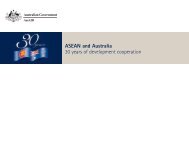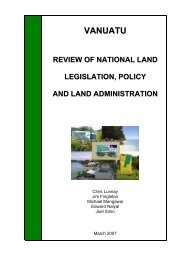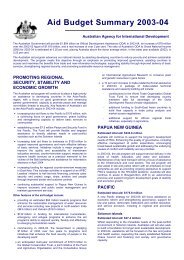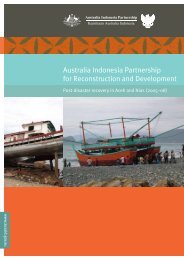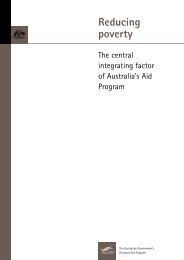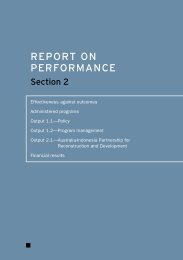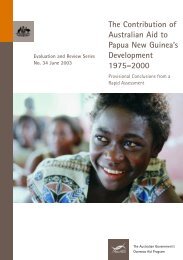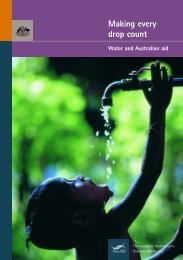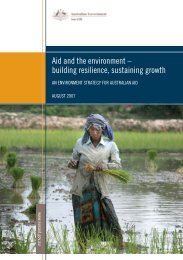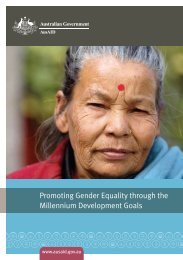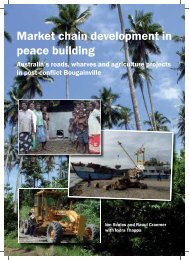Adviser Remuneration Framework - AusAID
Adviser Remuneration Framework - AusAID
Adviser Remuneration Framework - AusAID
You also want an ePaper? Increase the reach of your titles
YUMPU automatically turns print PDFs into web optimized ePapers that Google loves.
<strong>Adviser</strong> <strong>Remuneration</strong> <strong>Framework</strong>Version 3 – February 20121 of 20
Contents1. INTRODUCTION 31.1 <strong>Adviser</strong> <strong>Remuneration</strong> <strong>Framework</strong> 31.2 Objectives 31.3 <strong>Adviser</strong> definition 32. APPLICABILITY OF THE FRAMEWORK 33. HOW TO USE THE FRAMEWORK 43.1 Determine the need for an adviser 53.2 Prepare Terms of Reference 53.3 Determine if the <strong>Framework</strong> applies 53.4 Classify the Terms of Reference against the <strong>Framework</strong> 6i. Duration of engagement 6ii. Professional Discipline Categories 6iii. Job Levels 63.5 Undertake a selection process 73.6 Determine remuneration offer 7i. Determine pay point 7ii. Allowances 8iii. <strong>Adviser</strong> Support Costs 93.7 Making an offer to the preferred candidate 10i. Management fees 103.8 Prepare and sign contract 11Attachment A : Short-term <strong>Adviser</strong> <strong>Remuneration</strong> Tables 12Attachment B : Long-term <strong>Adviser</strong> <strong>Remuneration</strong> Tables 14Attachment D : Job Levels 202 of 20
1. INTRODUCTION1.1 <strong>Adviser</strong> <strong>Remuneration</strong> <strong>Framework</strong>The <strong>Adviser</strong> <strong>Remuneration</strong> <strong>Framework</strong> (the <strong>Framework</strong>) defines <strong>AusAID</strong>’s policies and proceduresfor determining the remuneration of commercially contracted international advisers. The<strong>Framework</strong> requires that advisers are paid in accordance with the market-based remunerationrates and prescribed set of allowances outlined in this document. Benchmarked against other aidagencies and Australian labour market standards, the <strong>Framework</strong> ensures that adviserremuneration represents value for money and is appropriate to the type and level of technicalexpertise required for each particular task. The <strong>Framework</strong> also defines how adviser performancehistory is to be documented and used to inform future employment and to ensure the agency isachieving value for money. This document explains how <strong>AusAID</strong> staff and managing contractorsare expected to apply the <strong>Framework</strong> to their adviser engagements.1.2 ObjectivesThe <strong>Framework</strong> has three main objectives:• Market-tested competitive remuneration – to ensure <strong>AusAID</strong> is not paying above marketvalue for commercially contracted advisers.• Consistency – to remove the potential for over-paying advisers by capping remuneration andminimising scope for negotiation through a standardised remuneration scale.• Value for money – to demonstrate value for money achieved from commercially contractedinternational advisers by applying market-tested remuneration rates and assessing pastperformance history more thoroughly.1.3 <strong>Adviser</strong> definitionAn adviser is an individual who provides advice on the strategic direction and/or implementation ofthe Australian aid program. This includes:• technical expertise and advice to counterpart governments and/or other in-countrydevelopment partners;• technical advice to <strong>AusAID</strong> on the delivery of the aid program; or• leadership and oversight or technical inputs for the delivery of an <strong>AusAID</strong> project.2. APPLICABILITY OF THE FRAMEWORK2.1 The <strong>Framework</strong> only applies to advisers who are contracted:• commercially – either directly by <strong>AusAID</strong> or via a managing contractor (note: managingcontractors include non-government organisations if the basis of the funding agreementwith <strong>AusAID</strong> is a commercial contract); and• internationally – adviser positions are classified as ‘international’ where the requiredexpertise cannot be sourced locally, either because the local market is not mature enoughor the required skills being transferred to the beneficiary country can only be obtained from3 of 20
abroad. It is important to note that this classification does NOT relate to the nationality ofthe adviser.2.2 Note that this means the <strong>Framework</strong> does not apply to:• non-project, ongoing administrative and head office staff of managing contractors;• ‘locally engaged staff’ engaged through the local labour market (including those in advisoryand administrative or logistical roles);• Australian public servants (including those in advisory roles) engaged through employmentcontracts on Australian Public Service terms and conditions;• individuals (including those in advisory roles) engaged through the terms and conditions ofa grant agreement using the grant recipient’s own procurement processes (e.g. partnergovernments, bilateral or multilateral organisations);• individuals engaged in humanitarian and emergency response missions at the time ofcrisis; or• volunteers.For all engagements relating to <strong>AusAID</strong> staff advisers, overseas-based staff and whole-ofgovernmentdeployees, <strong>AusAID</strong> staff may contact Human Resources Branch for informationrelating to remuneration, terms and conditions and recruitment processes.3. HOW TO USE THE FRAMEWORKQuick Guide to using the <strong>Framework</strong>:1. Determine the need for an adviser2. Prepare Terms of Reference3. Determine if the <strong>Framework</strong> applies4. Classify the Terms of Reference against the <strong>Framework</strong>:i. Determine duration of engagement, i.e. whether short term or long term.ii. Identify the expertise – the professional discipline category.iii. Identify the level of responsibility – the job level.5. Undertake a selection process to identify suitable candidates.6. Determine remuneration offeri. Determine appropriate pay point in the applicable <strong>Framework</strong> remuneration table.ii. Determine eligibility of preferred candidate for allowances – use the <strong>Remuneration</strong>iii. Calculator to calculate the total remuneration package.iv. Determine adviser support costs7. Make an offer to the preferred candidate and negotiate management fee, where applicable.8. Prepare and sign contract, subject to relevant approvals.4 of 20
3.4 Classify the Terms of Reference against the <strong>Framework</strong>There are three factors that determine the classification of the adviser position under the<strong>Framework</strong>:• Duration of engagement (short term or long term)• Required expertise/skills for the position (Professional Discipline Categories A to D)• Required level of experience (Job Levels 1 to 4)The combination of these three factors provides a remuneration range in the <strong>Framework</strong>remuneration tables at Attachments A and B.i. Duration of engagementA long-term engagement is when an adviser is engaged for more than six months of continuousinputs over the contract period. Long-term advisers are paid a monthly remuneration rate. Anyother arrangement is considered short term and the adviser is paid a daily remuneration rate.If continuation of a short term adviser input is required beyond six months the position may beextended at the agreed short-term rates or reclassified as long term depending on thecircumstances of the extension. This will require a contract amendment and early engagementwith <strong>AusAID</strong>’s Procurement and Agreement Services will help ensure the transition is effectivelyhandled.Where a team of long and short-term advisers is required, using a managing contractor hasadministrative advantages – especially where team composition cannot be clearly defined at theoutset. The technical support provided by a managing contractor may also be preferable in somecases where replacement personnel need to be mobilised quickly.ii.Professional Discipline CategoriesThe <strong>Framework</strong> describes four Professional Discipline Categories (A to D) which are listed inAttachment C. Each category reflects the difference in market value of different professionaldisciplines. You must match the skills required to the appropriate category for the adviser position.Where a position contains significant elements of more than one discipline the role should beremunerated at the rate of the Professional Discipline Category that comprises the majority of therole.If you are seeking expertise that is not defined in the Professional Discipline Categories, youshould choose the category that includes a comparable discipline. Where no comparable disciplineexists, you will need to undertake market research in order to determine the appropriate category.Proposed rates must be cleared by Procurement and Agreements Services through the standardcontract clearance process.iii.Job LevelsThe <strong>Framework</strong> describes four Job Levels (1 to 4) which are listed in Attachment D. The JobLevels provide a guide to the complexity, responsibility, accountability and experience that wouldtypically be expected from an adviser in the position.6 of 20
<strong>AusAID</strong> should consider the full range of Job Levels, and staff are encouraged to classify adviserroles at lower levels where the skills gained at an earlier career stage are sufficient for the role.Job Levels 1 to 3 represents the spectrum of entry, mid and senior levels. Job Level 4 representsroles equivalent to the senior executive tier of an organisation. For example, an Executive Directorof an organisation; team leader of a large, high risk and complex multi-disciplinary team (e.g. largeinfrastructure project); or a senior adviser reporting to or working alongside the executive tier of theorganisation.3.5 Undertake a selection processThe <strong>Framework</strong> applies to both competitive selection processes and direct sourcing. Where the<strong>Framework</strong> applies, all advertised positions must clearly state the <strong>Framework</strong> classification in theTerms of Reference (e.g. short term C3 or long term B2) and attach the remuneration tablescontained in Attachments A and B of this document. Allowances and management fees will bepayable subject to the adviser meeting conditions outlined in the <strong>Framework</strong> and at <strong>AusAID</strong>’sdiscretion.3.6 Determine remuneration offerThe <strong>Framework</strong> remuneration tables at Attachments A and B provide an Entry Rate, MarketReference Point (MRP) and Maximum Rate.• <strong>Adviser</strong>s who meet the minimum level of experience identified in the Job Level descriptionwill be offered the Entry Rate.• <strong>Adviser</strong>s who exceed the minimum appropriate experience for the relevant job level will beoffered a rate that can be up to and including the MRP.• Positions identified as requiring scarce skills or advisers with a relevant and demonstratedoutstanding performance history can be remunerated at a Premium Rate up to andincluding the Maximum Rate with appropriate authorisation. <strong>Remuneration</strong> at premiumrates is at the discretion of the relevant <strong>AusAID</strong> First Assistant Director General (FADG).• Only the <strong>AusAID</strong> Director General is authorised to approve pay offers beyond the MaximumRate.Note: All rates in the <strong>Framework</strong> remuneration tables are inclusive of superannuation. <strong>Framework</strong>rates for long-term advisers are inclusive of 20 days annual leave. <strong>Adviser</strong>s wishing to take morethan 20 days leave over the course of a year will need to ‘purchase’ the additional leave on a prorata basis in line with the conditions of the contract.i. Determine pay pointTo determine the appropriate pay point in the remuneration tables at Attachments A and B, youmust:• determine whether the position requires scarce skills; and• assess the preferred candidate’s credentials and past performance history.Scarce Skills7 of 20
Scarce skills refer to a shortage of sufficiently qualified or experienced candidates. This could bedue to, for instance, skills being related to a new emerging occupation or special licensing orregistration requirements necessary for the role.Each case of scarce skills for an adviser position must be assessed on a case by case basis. Noblanket exemptions apply.Where the necessity for scarce skills is identified prior to sourcing the adviser, the Terms ofReference or advertised position will indicate if the role has been identified as having premiumrates applicable. This must be approved by the relevant <strong>AusAID</strong> FADG prior to approaching themarket. Similarly, if scarce skills are identified after approaching the market, an offer of premiumrates to the preferred candidate must be approved by the <strong>AusAID</strong> FADG.Performance HistoryBefore making a pay offer to the preferred candidate, you must check the preferred candidate’sperformance history. Refer to <strong>AusAID</strong>’s Guideline on Contractor and <strong>Adviser</strong> PerformanceAssessments for comprehensive information on this issue, including definitions of performanceratings. Relevant to the application of the <strong>Framework</strong>, it is important to note that:• A good performance history or referee checks can be used to justify a pay offer up to the<strong>Framework</strong> MRP.• An outstanding performance record with <strong>AusAID</strong> or through other demonstrated meansover the past five years may be used to support a business case to pay premium rates.• A record of less than satisfactory performance over the past five years may indicate a casenot to engage the candidate.• Referee reports and performance information from other sources may be consideredalongside <strong>AusAID</strong> performance assessments in determining whether an adviser’sperformance history justifies a remuneration offer at premium rates.For all adviser engagements and re-engagements <strong>AusAID</strong> staff must check the Contractor and<strong>Adviser</strong> Performance Register, and contact <strong>AusAID</strong>’s Agreements, Safeguards and PartnerPerformance team to obtain performance information for past assignments from the Registerbefore making an offer.Managing contractors should request the <strong>AusAID</strong> staff managing the activity to check the Registerfor adviser personnel they wish to engage for an <strong>AusAID</strong>-funded activity. For information on theuse of performance information during a tender process refer to the specific request for tenderdocumentation issued by <strong>AusAID</strong>.Note that copies of <strong>Adviser</strong> Performance Assessments will not be released outside <strong>AusAID</strong>.ii.AllowancesIn addition to the remuneration rate, advisers may also be eligible for additional entitlements (i.e.allowances). When these are agreed, the <strong>Adviser</strong> <strong>Remuneration</strong> Calculator should be used todetermine the total remuneration package for adviser positions.Short term <strong>Adviser</strong>sFor short-term advisers, fixed daily travel rates (or per diems) are prescribed by <strong>AusAID</strong> for eachcountry, which are in line with equivalent rates paid to <strong>AusAID</strong> staff undertaking short term travel.8 of 20
Long term <strong>Adviser</strong>sAllowances to long term advisers are payable at <strong>AusAID</strong>’s discretion. Long term advisers may beeligible for:• Mobility Allowance: intended to compensate advisers for personal impacts and cost of livingdifferences associated with leaving their permanent country of residence on a long-term basis.This allowance is based on an equivalent allowance for long-term <strong>AusAID</strong> posted staff. It iscalculated as a percentage of salary and varies depending on whether the adviser isaccompanied by a spouse or partner.• Special Location Allowance: may apply to advisers engaged in the following locations asdetermined by <strong>AusAID</strong> in its conditions for overseas service: Iraq, Afghanistan, Pakistan andremote localities outside capital cities in other countries.iii.<strong>Adviser</strong> Support Costs<strong>Adviser</strong> support costs are expenses incurred by the adviser that are directly related to theirassignment. These costs are reimbursed by <strong>AusAID</strong> at cost and up to a prescribed limit set by<strong>AusAID</strong> in the contract. Support costs for short and long term advisers may include, but not belimited to:⋅ Short-term accommodation⋅ Airfares and other work related transport costs⋅ Compulsory arrival and departure taxes⋅ International communication costs⋅ Medical insurance⋅ Security costs, where applicableIn addition long term advisers may also be eligible for reimbursement of reasonable costsassociated with⋅⋅⋅Long-term accommodationMobilisation/demobilisationLearning and development costs required for the position, as agreed by <strong>AusAID</strong>Accommodation costsAccommodation (hotel) costs for short-term advisers, as defined in the contract, are prescribed by<strong>AusAID</strong> for each country, which are in line with equivalent rates paid to <strong>AusAID</strong> staff undertakingshort term travel.Accommodation (rental) costs for long-term advisers are capped and reimbursed at actual costincurred. It is not payable if a spouse/partner is already receiving housing allowance from <strong>AusAID</strong>or another employer.<strong>AusAID</strong> maintains a list of maximum monthly accommodation rates for long term advisers by city,which is updated annually based on location-specific market data for rental accommodation. Therates reflect the monthly rental cost of an expatriate-standard mid-range three bedroom apartment.For locations not included in <strong>AusAID</strong>’s long-term accommodation caps, advisers should obtainthree quotes demonstrating a reasonable effort to obtain accommodation at the standarddescribed. The lowest-cost quote can be approved where <strong>AusAID</strong> finds the quote reasonable.Records must be kept to allow verification that this process has been followed.<strong>Adviser</strong>s may choose to share accommodation where <strong>AusAID</strong> finds this is reasonable andprovides value for money. In this instance <strong>AusAID</strong> will reimburse each individual adviser’scontribution to the lease upon proof of expense.9 of 20
<strong>Adviser</strong>s may choose to rent accommodation at a higher rate than is covered by <strong>AusAID</strong>’smaximum monthly accommodation rates for the relevant location. Excess rental costs will be at theadviser’s own expense.Managing contractors should request the relevant accommodation rates from <strong>AusAID</strong> staffmanaging the activity for adviser personnel they wish to engage.3.7 Making an offer to the preferred candidateAfter you have calculated the preferred candidate’s total remuneration package and support costs,you may make an offer to the preferred candidate. If the adviser is eligible to charge managementfees, the following applies.i. Management feesManagement fees 1 vary depending on the market, company structure, location where services willbe provided and the nature of services being procured. They will be determined on a case by casebasis as a result of a competitive approach to market. In instances where advisory services aredirectly sourced without a competitive process, <strong>AusAID</strong> staff should seek advice from Procurementand Agreement Services through the standard contract clearance process.<strong>AusAID</strong>’s treatment of management fees will vary according to the selection process and nature ofthe adviser engagement.• For advisers engaged through an open competitive procurement process, either for individualactivities or as part of teams, tender documentation will be structured so that managementfees are separated from individual adviser remuneration and any identified adviser supportcosts. Management fees will be assessed through the competitive assessment of tenderproposals.• For individual advisers, management fees are limited to insurance costs that are not solelylinked to the current assignment and therefore will not be reimbursed at cost (e.g. professionalindemnity insurance) and a contribution to any office running costs. These overheads must bejustified and clearly documented and may not exceed ten per cent of the total adviserremuneration. Individual advisers cannot charge for profit.For advisers engaged through a company, management fees must be clearly documented andjustified. <strong>AusAID</strong> staff must carefully consider this justification prior to passing to Procurement andAgreement Services for clearance. Eligible management fee components will be defined in thecontract and may include:⋅⋅⋅⋅⋅profits, including commercial margins and mark-up for personnel and projectmanagement;financial management costs;costs of contractor administrative and head office staff, including the cost of acontractor representative, if any;costs associated with establishing and maintaining premises and equipment, includingutilities;insurance costs as required by the contract, but exclusive of the costs of medicalinsurance for advisers;1 <strong>AusAID</strong> contracts and tender documentation will prescribe what is chargeable in the management fee. As ageneral rule the management fee may include indirect overheads (i.e. legitimate costs that are indirectlyattributable to the adviser assignment), direct overheads (i.e. legitimate costs directly attributable to theassignment that are not covered in adviser support costs) and/or company profit.10 of 20
⋅⋅⋅⋅⋅⋅⋅taxation, as applicable;costs of complying with the contractor’s reporting and liaison obligations under thecontract;costs associated with all personnel briefings in Australia or in-country;costs associated with any subcontracting and procurement of goods and services;costs, including domestic and international travel, accommodation, per diems, andlocal transport costs where required for contractor head office personnel;any other overheads required to perform the services;any escalators; and any allowance for risks and contingencies.3.8 Prepare and sign contractWhen all adviser costs have been agreed between the relevant parties, the preparation andsigning of a contract may proceed. <strong>AusAID</strong> staff must ensure they have sought all relevantFMA9/10 approval/s for spending proposals relating to advisers, that the draft contract has beencleared by Procurement and Agreement Services (PAS), and all PAS comments and amendmentshave been actioned and section 44 approval/s have been sought to enter into a contract with thepreferred adviser or managing contractor.An adviser’s remuneration under the <strong>Framework</strong> is specified in the contract and remains for theduration of the contract, regardless of any changes to <strong>Framework</strong> rates that may be madesubsequent to the contract being signed. For long term engagements, advisers may be able tonegotiate an escalator to <strong>Framework</strong> rates in their contract, based on reasonable and agreedincreases due to anticipated increases in the cost of living.11 of 20
Attachment A : Short-term <strong>Adviser</strong> <strong>Remuneration</strong> TablesDiscipline Group AJob levelEntry rateYears of relevantexperienceAUD - daily remuneration ratesYears of relevantexperienceMRP Premium rates Maximum1 308 Up to 2 347 >2 to 5 385 4622 408 Up to 5 459 >5 to 10 510for advisers with anoutstandingperformance history6123 540 Up to 10 607 >10 to 15 674 or for scarce skills 8094 618 Up to 15 696 >15 773 928Discipline Group BJob levelEntry rateYears of relevantexperienceAUD - daily remuneration ratesYears of relevantexperienceMRP Premium rates Maximum1 302 Up to 2 340 >2 to 5 378 4542 436 Up to 5 490 >5 to 10 545for advisers with anoutstandingperformance history6543 565 Up to 10 636 >10 to 15 707 or for scarce skills 8484 649 Up to 15 730 >15 811 973Discipline Group CJob levelEntry rateYears of relevantexperienceAUD - daily remuneration ratesYears of relevantexperienceMRP Premium rates Maximum1 318 Up to 2 358 >2 to 5 398 4782 433 Up to 5 487 >5 to 10 541for advisers with anoutstandingperformance history6493 593 Up to 10 667 >10 to 15 742 or for scarce skills 8904 682 Up to 15 768 >15 853 102412 of 20
Discipline Group DJob levelEntry rateYears of relevantexperienceAUD - daily remuneration ratesYears of relevantexperienceMRP Premium rates Maximum1 354 Up to 2 399 >2 to 5 443 5312 491 Up to 5 553 >5 to 10 614for advisers with anoutstandingperformance history7373 679 Up to 10 764 >10 to 15 849 or for scarce skills 10184 774 Up to 15 871 >15 968 116113 of 20
Attachment B : Long-term <strong>Adviser</strong> <strong>Remuneration</strong> TablesDiscipline Group AJob levelEntry rateYears of relevantexperienceAUD - monthly remuneration ratesYears of relevantexperienceMRP Premium rates Maximum1 5,658 Up to 2 6,366 >2 to 5 7,073 8,4882 7,482 Up to 5 8,418 >5 to 10 9,353for advisers with anoutstandingperformance history11,2243 9,918 Up to 10 11,158 >10 to 15 12,398 or for scarce skills 14,8784 11,322 Up to 15 12,737 >15 14,152 16,983Discipline Group BJob levelEntry rateYears of relevantexperienceAUD - monthly remuneration ratesYears of relevantexperienceMRP Premium rates Maximum1 5,590 Up to 2 6,289 >2 to 5 6,988 8,3862 8,061 Up to 5 9,068 >5 to 10 10,076for advisers with anoutstandingperformance history12,0913 10,412 Up to 10 11,714 >10 to 15 13,015 or for scarce skills 15,6194 11,907 Up to 15 13,395 >15 14,883 17,860Discipline Group CJob levelEntry rateYears of relevantexperienceAUD - monthly remuneration ratesYears of relevantexperienceMRP Premium rates Maximum1 5,887 Up to 2 6,623 >2 to 5 7,358 8,8302 8,026 Up to 5 9,029 >5 to 10 10,032for advisers with anoutstandingperformance history12,0393 10,946 Up to 10 12,314 >10 to 15 13,683 or for scarce skills 16,4194 12,545 Up to 15 14,114 >15 15,682 18,81814 of 20
Discipline Group DJob levelEntry rateYears of relevantexperienceAUD - monthly remuneration ratesYears of relevantexperienceMRP Premium rates Maximum1 6,601 Up to 2 7,426 >2 to 5 8,251 9,9012 9,156 Up to 5 10,301 >5 to 10 11,445for advisers with anoutstandingperformance history13,7343 12,620 Up to 10 14,197 >10 to 15 15,774 or for scarce skills 18,9294 14,335 Up to 15 16,127 >15 17,918 21,50215 of 20
Attachment C : Professional Discipline CategoriesDiscipline Category Group AGeneral Administration and Corporate ServicesAdministrative ServicesContracting and PurchasingFacilities/TravelProgram BudgetingPrinting/Graphics & CartographyHuman Resources AdministrationFinancial ManagementPublic Affairs and CommunicationData and Information ServicesDocumentation and Records ManagementComputers/Communications & Technical Support, incl:Hardware, software and trainingWeb maintenance/Homepage designAccounting, Audit and StatisticsAccountingInternal AuditStatisticsProcurement and Grant Administrative ServicesAdministrative Services and SupportTender and Grant Process Administration16 of 20
Discipline Category Group BAgricultureAgricultural ExtensionsAgro Industry/Agribusiness ManagementAgronomyFisheriesForestryLivestockNatural Resource ManagementTree CropsStatisticsFood Security and Rural DevelopmentAgricultural productivityRural Market DevelopmentSocial ProtectionHumanitarian, Emergency, Risk ManagementHumanitarian PolicyInformation SystemsCommunicationsData Communications and Infrastructure, incl:Network administrationVoice communicationsSystems software design & implementationLarge scale data management- System designIT EngineeringSocial and Political ScienceHuman Resources DevelopmentLogisticsEducationTrainingPublic HealthNutritionNursingOccupational HealthResearchGenderGovernancePolitical Democratic GovernancePublic Sector ManagementGovernance Reforms and DecentralisationGovernance Support ServicesSocial DevelopmentSocial Development – Safeguards incl:resettlement and displacement of indigenouspeopleSocial DevelopmentChild ProtectionHuman RightsPolitical and Social Analysis and SocialChangeCommunications for Development (C4D)Community Development (Related toInfrastructure)Fragility and ConflictFragility and Conflict training and AdvisorySupport17 of 20
Discipline Category Group CBiological Sciences and EcologyBiological Sciences and EcologyBiotechnologyClimate Change and Environmental ServicesMitigating and Avoiding Greenhouse GasEmissionsClimate Change AdaptationAssessment/MonitoringBiodiversityWasteNatural ResourcesPollutionSustainable DevelopmentEconomics/Financial AnalysisEconomics/financial analysis, incl:Project feasibility studySector studyEconometrics modellingEnvironmental economicsFiscalInternational trade/FinanceLabour economics/employmentMacroeconomics (including policy)Management accountingMicroeconomicsMonetaryPovertyProcurement / Public Finance ManagementEngineeringArchitectureChemistryCarbon marketClean development mechanismsEnergyEnvironmental engineeringDue DiligenceDue DiligenceFinancial Due DiligenceInfrastructureTransportUrban DevelopmentEnergy and Information, Communicationsand TechnologyInfrastructure ManagementPublic BuildingsWater and SanitationIndustryMiningGeologyPetroleum GasPowerTelecommunicationsProject ManagementCountry Operations ManagementProject monitoring, operations & evaluationLegal (General)Medicine (General)DesignStrategic ProgrammingOperational Design (Activity and Program)Organisational Capacity Building (Strategydevelopment, design and monitoring andevaluation)Theory of Change/ Program Logic FacilitationMonitoring and EvaluationStrategic EvaluationStrategic Monitoring and ProgramPerformance SystemsActivity Monitoring and Performance SystemsActivity EvaluationCapacity DevelopmentHumanitarian, Emergency and Disaster RiskManagementDisaster Risk Management (DRM)Humanitarian Emergency and PreparednessResponseHumanitarian PolicyDisaster Risk Reduction (DRR)Assistance to Refugees and DisplacedPeopleProcurement and Grant AdministrationServicesProbity ServicesProcurement and grant policy / projectmanagementProcurement Assessment and CapacityDevelopment Advisory ServicesProcurementAssessment and Capacity DevelopmentAdvisory Services18 of 20
Discipline Category Group DFinance and Investment (specialised)BankingBuild OperateTransfer (sectoral/ country level)Capital MarketsFinance/Fund Management/Co-financeGuarantee/ InsuranceInternational tradeInvestmentPublic/Private PartnershipsSector Pricing/TariffsSpecialised Finance (insurance, social security, pension schemes)Institutional ReformOrganisational planning and managementStrategy developmentPrivate sector development and restructuringPrivate Sector Development/ PrivatisationPublic enterprise management and restructuringLegal (specialised)DeregulationJudicial Strengthening & RegulationPublic Finance Management & Fiscal DecentralisationGovernanceGovernance reforms and Decentralisation19 of 20
Attachment D : Job LevelsLevel Description1234Performs a variety of research andanalytical tasks requiring independentinitiative. However, the overall direction ofthe work is clearly defined and forms acomponent of a larger project. Work isperformed under guidance. Contactswith counterparts predominantly at theadministrative level.Performs professional level analysis orresearch requiring technical skills andindependent initiative within a welldefined program of work. Works withlimited supervision. Contacts withcounterparts predominantly at a workinglevel.Provides informed technical or policyadvice and or advises on complexprogram. Ability to coordinatecontributions of other specialists tocomplete a joint project. Recognised asan expert in the field with appropriateacademic qualifications and substantialprofessional experience. Contacts withcounterparts predominantly atstrategic/management level.Acts as a senior adviser on major policywork or is responsible for leadingcomplex projects/programs, usuallyinvolving the participation of one or moremultidisciplinary teams. Strong academicbackground and or internationallyrecognised professional status in thefield. Extensive relevant professionalexperience including at senior advisory ormanagerial levels. Contacts withcounterparts predominantly atstrategic/management level.Indicative requirements• Up to 5 years relevant experience inone or more professional disciplines,or equivalent combination of relevanteducation and experience.• Theoretical base in subject area, withability to translate theory into practice• Thematic/regional knowledge (whererequired)• 5 or more years relevant experiencein one or more professionaldisciplines, or equivalent combinationof relevant education and experience.• Thorough knowledge of functionalarea, combining a broad grasp ofrelevant theory and principles• Ability to participate in multidisciplinary teams and to workindependently.• Strong thematic/regional knowledge(where required)• 10 or more years relevant experiencein one or more professionaldisciplines, or equivalent combinationof relevant education and experience.• Strong theoretical base in subjectarea, with ability to translate theoryinto practice• Leadership with ability to function asteam leader and ability to coach andmentor more junior staff.• Thematic/regional expertise (whererequired)• 10 or more years professionalexperience or equivalent combinationof education and experience.• Outstanding theoretical base insubject area, with ability toconceptualise, design and implementmajor projects and to producemajor/complex reports or studies.• Outstanding thematic/regionalexpertise (where required)• Demonstrated professional leadershipand ability to lead a team ofprofessionals and ability to coach andmentor more junior staff.20 of 20



